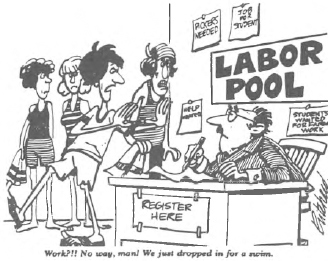News & Events More |
Roygold Reports, 1982Fighting back against an economic recession and realizing the need for even greater efficiency in operations, the 1982 Convention of the B.C.F.G.A. commissioned a study of programs and procedures, with particular attention to how pooling structures and packing allowances affected incentives to improve quality. Due to central pooling, the widely different capabilities of packing houses were causing stresses in the industry. Increasing the problem was the Washington State apple crop. Over the last twenty years it had grown to 2.8 billion pounds a year. British Columbia produced 400 million pounds. This made for fierce competition on foreign and domestic markets for B.C. Tree Fruits Ltd., which was competing at the very same time against local independent growers and fruitlegging members. Therefore, it was important for the B.C.F.G.A. to learn how its members could be more competitive. 
The B.C.F.G.A. commissioned Max Roytenberg of Roygold Marketing Systems Ltd. to conduct two studies on the B.C. tree fruit industry. His July report, while strongly supporting central selling and the B.C.F.G.A., recommended improvement in the way the industry was organized. Under general pooling, the difference between what was paid to growers of good fruit and what was given to growers of lower quality produce was not great enough. Incentives to grow better quality fruit needed to be established. The voluntary arrangement of single-desk selling from a central pool was not matched by coordination among packing houses. This appeared to penalize those packing houses investing in new technologies, and created potential unfairness in the pooling system. Internal rivalries and inequities were making the autonomous packing houses less competitive against their American rivals. In addition to packing house problems, market responsiveness problems were identified. The study forecast two future scenarios which would improve equity and industry effectiveness against American and other foreign competition. It seems likely that the industry will either agree on a unitary form of organization, or end by being dominated by two or three large packing organizations marketing through a central selling organization or individually. In the first instance, all growers will be better off . . . in the latter instance . . . on the average growers may be worse off. The first scenario recommended the ten packing houses unite under the B.C.F.G.A. Growers would naturally be better off. Based on the first report, a second study was commissioned to investigate the potential cost/benefits of integrating the B.C. tree fruit industry and making it more competitive. This final report pointed out that F.I.I. was only temporarily cushioning the decline in grower returns caused by increasing continental competition. Industry integration appeared to be the obvious solution to increasing the returns available to growers. The packing houses would come under one administration while still keeping their regional identities. However, they would cease to be purely autonomous agencies. In addition, it was suggested that through amalgamation of packing houses, packing would become a year round activity. To make year-long packing house activity feasible, increased controlled atmosphere storage was needed. Thus, the reports recommended that the industry make itself more competitive by integrating the packing houses, by eliminating some packing houses, and by extending the packing season. The report hinted that there was further need to analyse market responsiveness. Although some amalgamation of packing houses was to occur later, at the time the rivalries were too great between the geographic regions and the various packing houses. In addition, growers were concerned that the projected savings were only hypothetical and not necessarily real. The proposed industry integration did not happen. Contact Us Hours: 9am - 4pm weekdays. t: 250-762-5226 |

